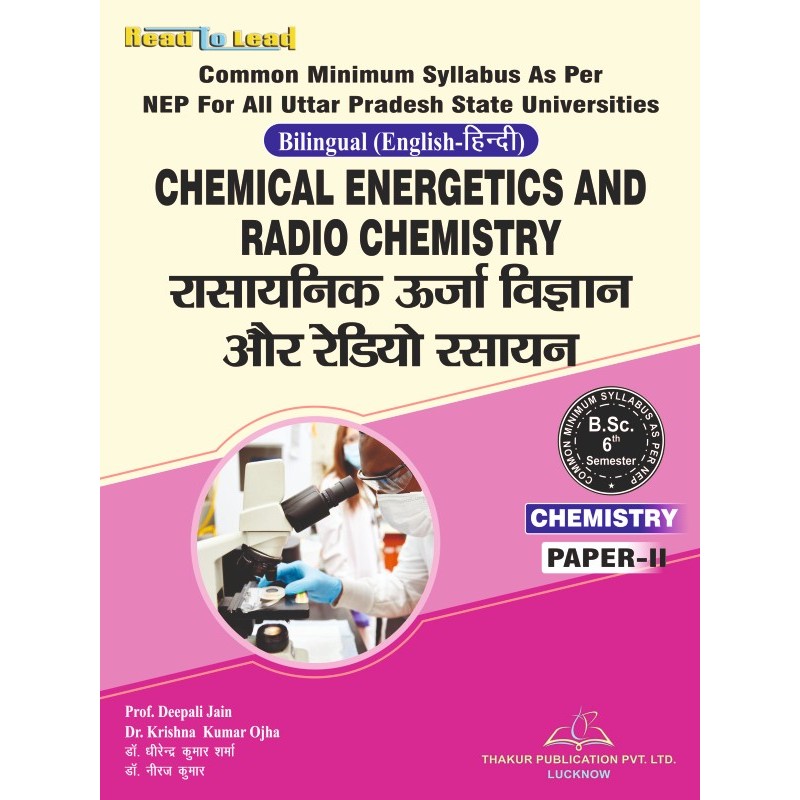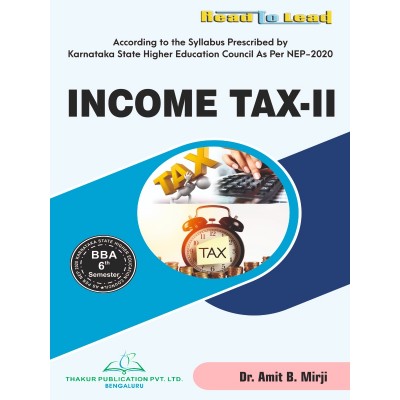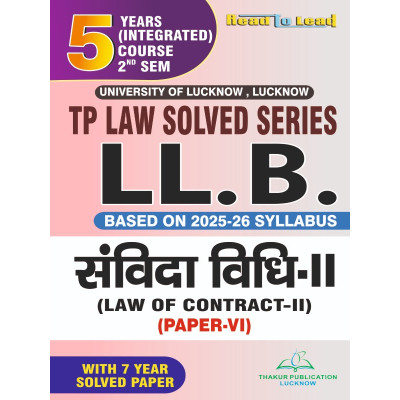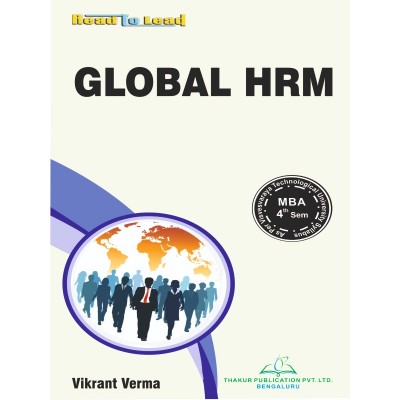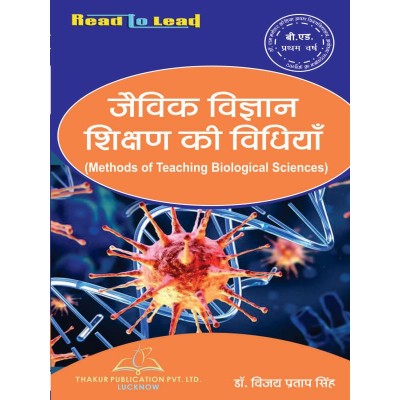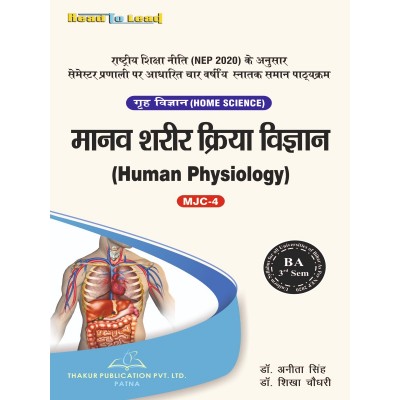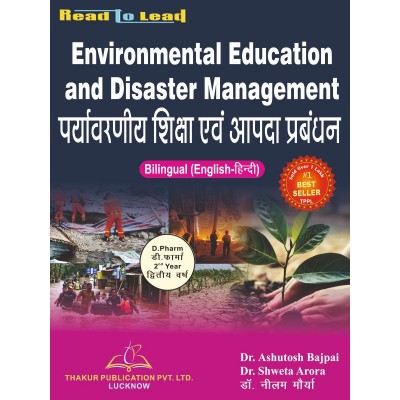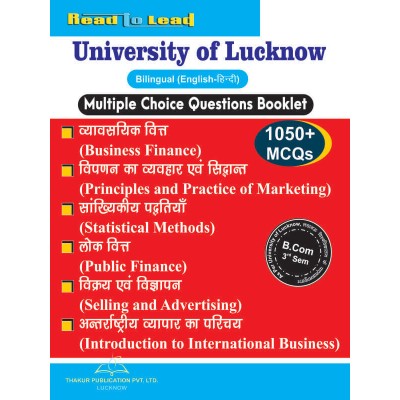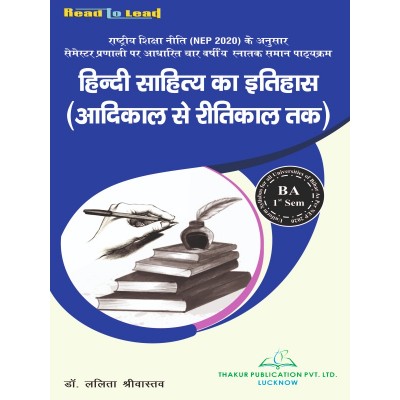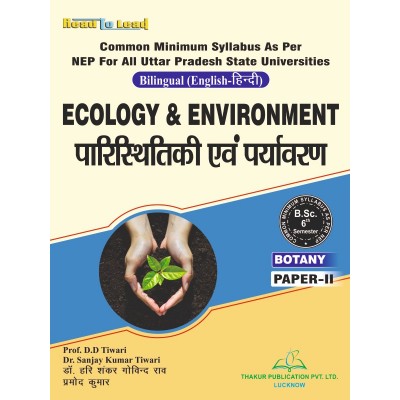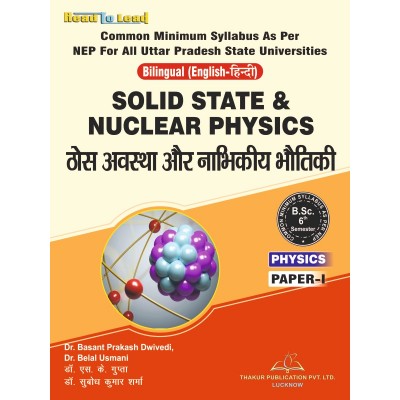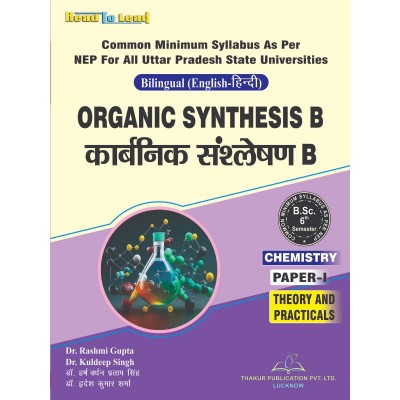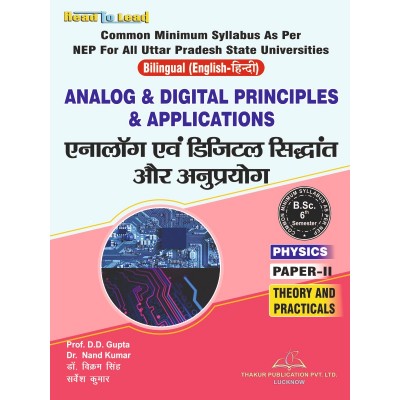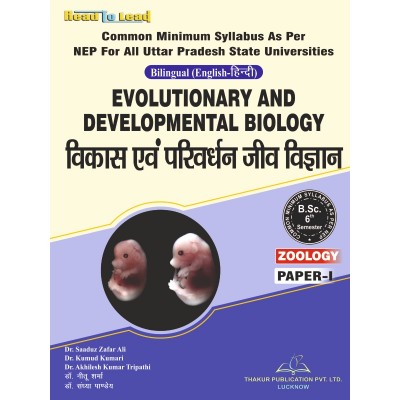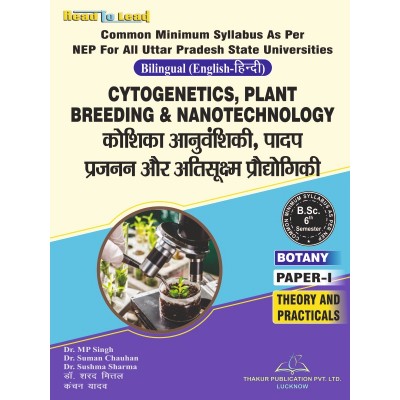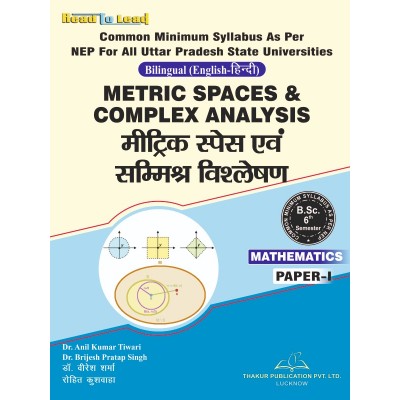Chemistry ( Paper-II ) Chemical Energetics and Radio Chemistry ( रासायनिक ऊर्जा विज्ञान और रेडियो रसायन ) U.P B.Sc 6th Sem
Tax excluded
Click below to Buy E-Book Edition:
Buy Latest Chemistry ( Paper -II ) Chemical Energetics and Radio Chemistry ( रासायनिक ऊर्जा विज्ञान और रेडियो रसायन ) Book in Bilingual Edition ( Both English and Hindi ) Languages for B.Sc 6th Semester Common Minimum Syllabus As Per NEP for All Uttar Pradesh State Universities By Thakur Publication. Written by Experienced Authors | Fast & All India Delivery |
AUTHORS: Prof. Dipali Jain , Dr. Krishna Kumar Ojha , Dr. Dhirendra kumar Sharma ,Dr. Neeraj Kumar
ISBN : 978-93-5755-892-1
Syllabus ¼ikB~;Øe½
Chemistry (Paper II): Chemical Energetics and Radio Chemistry
jlk;u foKku ¼Á’u i= II½& jklk;fud ÅtkZ foKku vkSj jsfM;ks jlk;u
Course Code: B020602T
|
Unit |
Topics |
Hrs |
|
|
I |
Thermodynamics - I First Law of Thermodynamics: Statement, definition of internal energy and enthalpy. Heat capacity, heat capacities at constant volume and pressure and their relationship. Joule’s law – Joule[1]Thomson coefficient and inversion temperature. Calculation of w, q, dU & dH for the expansion of ideal gases under isothermal and adiabatic conditions for reversible process.
Thermochemistry: Standard state, standard enthalpy of formation – Hess’s law of heat summation and its applications. Heat of reaction at constant pressure and at constant volume. Enthalpy of neutralisation. Bond dissociation energy and its calculation from thermo-chemical data, temperature dependence of enthalpy. Kirchhoff’s equation. |
Å"ekxfrdh - I Å"ekxfrdh dk izFke fu;e& fooj.k] vkarfjd ÅtkZ vkSj ,UFkSYih dh ifjHkk"kkA Å"ek /kkfjrk] fLFkj vk;ru vkSj nkc ij Å"ek /kkfjrk vkSj mudk laca/kA twy dk fu;e & twy Fk‚elu xq.kkad vkSj O;qRØe rkiekuA mRØ.kh; çØe ds fy, lerkih vkSj #)ks"e fLFkfr;ksa ds varxZr vkn'kZ xSlksa ds foLrkj ds fy, w, q, dU vkSj dH dh x.kukA
Å"ekjlk;u& ekud voLFkk] xBu dh ekud ,UFkSYih & gst dk Å"ek ;ksx dk fu;e vkSj mlds vuqç;ksxA fLFkj nkc vkSj fLFkj vk;ru ij vfHkfØ;k dh Å"ekA mnklhuhdj.k dh ,UFkSYih ca/k fo;kstu ÅtkZ vkSj FkeksZ&jklk;fud MsVk ls bldh x.kuk] ,UFkSYih dh rkieku fuHkZjrkA fdjp‚Q dk lehdj.kA |
08 |
|
II |
Thermodynamics - II Second Law of Thermodynamics, Need for the law, different statements of the law, Carnot cycle and its efficiency. Carnot theorem. Thermodynamic scale of temperature. Concept of Entropy, Entropy as a state function, entropy as a function of V & T, entropy as a function of P & T, entropy change in physical change, Clausius inequality , entropy as a criteria of spontaneity and equilibrium. Entropy change in ideal gases and mixing of gases. Gibbs and Helmholtz Functions Gibbs function (G) and Helmhotz function (A) as thermodynamic quantities. A & G as criteria for thermodynamic equilibrium and spontaneity, their advantage over entropy change, Variation of G and A with P, V and T. Third Law of Thermodynamics; Nernst heat theorem, statement and concept of residual entropy. Nernst distribution law – Thermodynamic derivation, applications. |
Å"ekxfrdh& II Å"ekxfrdh dk f}rh; fu;e] fu;e dh vko';drk] fu;e ds fofHkUu dFku] dkuksZV pØ vkSj bldh n{krkA dkuksZV çes;- rkieku dk Å"ekxfrdh iSekuk- ,UVª‚ih dh vo/kkj.kk] ,d voLFkk Qyu ds :i esa ,UVª‚ih] V vkSj T ds ,d Qyu ds :i esa ,UVª‚ih] P vkSj T ds ,d Qyu ds :i esa ,UVª‚ih] HkkSfrd ifjorZu esa ,UVª‚ih ifjorZu] Dy‚fl;l vlekurk] Lor% vkSj lkE; ds ekunaM ds :i esa ,UVª‚ihA vkn'kZ xSlksa esa ,UVªkWih ifjorZu vkSj xSlksa dk feJ.kA fxCl vkSj gsYegksYV~t Qyu fxCl Qyu ¼G½ vkSj gsYegksYV~t Qyu ¼A½ Å"ekxfrd ek=k ds :i esaA Å"ekxfrdh lkE; vkSj Lor% ds ekunaM ds :i esa A vkSj G] ,UVªkWih ifjorZu ij mudk ykHk] P, V vkSj T ds lkFk G vkSj A dk fHkUurkA Å"ekxfrdh dk r`rh; fu;e] uuZLV rki çes;] dFku vkSj vof'k"V ,UVªkWih dh vo/kkj.kkA uuZLV forj.k fu;e & Å"ekxfrdh O;qRifÙk] vuqç;ksxA |
10 |
|
III |
Electrochemistry: Electrical Transport: Conduction in metals and in electrolyte solutions, specific conductance molar and equivalent conductance, measurement of equivalent conductance, variation of molar, equivalent and specific conductances with dilution. Migration of ions and Kohlrausch law, Arrhenius theory of electrolyte dissociation and its limitations. Weak and strong electrolytes. Ostwald's dilution law, its uses and limitations. Debye-Huckel-Onsager equation for strong electrolytes (elementary treatment only). Transport number, definition and determination by Hittorf method and moving boundary method. |
fo|qr jlk;u& fo|qr ifjogu& /kkrqvksa vkSj fo|qr vi?kV~; foy;uksa esa pkyu] fof'k"V pkyu eksyj vkSj rqY;kadh pkydrk] rqY;kadh pkydrk dk eki] eksyj dh fHkUurk] ruqdj.k ds lkFk lerqY; vkSj fof'k"V pkydRoA vk;uksa dk çoklu vkSj dksyjkm'k fu;e] fo|qr vi?kV~; fo;kstu dk vkjgsfu;l fl)kar vkSj bldh lhek,¡A nqcZy vkSj izcy fo|qr vi?kV~;A vksLVokYM dk ruqrk fu;e] blds mi;ksx vkSj lhek,¡A izcy fo|qr vi?kV~; ds fy, fMckbZ&gdy&v‚ulsxj lehdj.k ¼dsoy çkFkfed mipkj½A fgVkWQZ fof/k vkSj py ifjlhek fof/k }kjk vfHkxeukad] ifjHkk"kk vkSj fu/kkZj.kA |
08 |
|
IV |
Ionic Equilibrium: Electrode reactions, Nernst equation, derivation of cell EMF and single electrode potential, standard hydrogen electrode-reference electrodes and their applications, standard electrode potential, sign conventions, Electrolytic and Galvanic cells– Reversible and irreversible cells, conventional representation of electrochemical cells. EMF of a cell and its measurement. Definition of pH and pKa , determination of pH using hydrogen, quinhydrone and glass electrodes by potentiometric methods. Buffers – Mechanism of buffer action, Henderson-Hazel equation, application of buffer solution. Hydrolysis of salt. |
vk;fud lkE;& bysDVªksM vfHkfØ;k,a] uuZLV lehdj.k] lsy EMF vkSj ,dy bysDVªksM foHko dh O;qRifÙk] ekud gkbMªkstu bysDVªksM&lanHkZ bysDVªksM vkSj muds vuqç;ksx] ekud bysDVªksM foHko] fpUg ifjikVh] fo|qr vi?kVuh vkSj xSYosfud lsy&mRØe.kh; vkSj vuqRØe.kh; lsy] fo|qrjklk;fud lsy dk ikjaifjd fu#i.kA fdlh lsy dk EMF vkSj mldk ekiA pH vkSj pKa dh ifjHkk"kk] iksVsaf'k;ksesfVªd fof/k;ksa ls gkbMªkstu] fDougkbMªksu vkSj dk¡p bysDVªksM dk mi;ksx djds pH dk fu/kkZj.kA cQj & cQj fØ;kfof/k] gsaMjlu&gsty lehdj.k] cQj foy;u dk vuqç;ksxA yo.k dk ty vi?kVu |
10 |
|
V |
Photo Chemistry: Interaction of radiation with matter, difference between thermal and photochemical processes. Laws of photochemistry: Grothus- Drapper law, Stark-Einstein law, Jablonski diagram depicting various processes occurring in the excited state, qualitative description of fluorescence, phosphorescence, non-radiative processes (internal conversion, intersystem crossing), quantum yield, photosensitized reactions – energy transfer processes (simple examples), kinetics of photochemical reaction. |
izdk'k jlk;u & inkFkZ ds lkFk fofdj.k dh var%fØ;k] Å"eh; vkSj izdk’kjklk;fud çØe ds chp varjA izdk'k jlk;u ds fu;e& xzksFkl& Mªsij fu;e] LVkdZ&vkbaLVhu fu;e] tsCyksULdh vkjs[k mÙksftr voLFkk esa gksus okyh fofHkUu çØe dks n'kkZrk gS] çfrnhfIr] LQqjnhfIr] vfofdj.k çØe ¼vkarfjd :ikarj.k] varj ra= ØkWflax½] DokaVe yfC/k] QksVkslsaflVkbTM vfHkfØ;kvksa dk xq.kkRed fooj.k & ÅtkZ LFkkukarj.k çØe ¼ljy mnkgj.k½] izdk’kjklk;fud vfHkfØ;k dh xfrdhA |
04 |
|
VI |
Colligative Properties: Ideal and non-ideal solutions, methods of expressing concentrations of solutions, activity and activity coefficient. Dilute solution, colligative properties, Raoult's law, relative lowering of vapour pressure, molecular weight determination, Osmosis, law of osmotic pressure and its measurement, determination of molecular weight from osmotic pressure, Elevation of boiling point and depression of freezing, Thermodynamic derivation of relation between molecular weight and elevation in boiling point and depression in freezing point. Experimental methods for determining various colligative properties. Abnormal molar mass, Van't Hoff factor, Colligative properties of degree of dissociation and association of solutes. |
v.kqla[; xq.k/keZ& vkn'kZ vkSj vukn'kZ foy;u] foy;uksa dh lkaærk O;Dr djus dh fof/k;k¡] lfØ;rk vkSj lfØ;rk xq.kkadA ruq foy;u] lgla;kstd xq.k] jkmYV dk fu;e] ok"i nkc dk vkisf{kd voueu vk.kfod Hkkj fu/kkZj.k] ijklj.k] ijklj.k nkc dk fu;e vkSj mldk eki] ijklj.k nkc ls vk.kfod Hkkj dk fu/kkZj.k] DoFkukad dk mUu;u vkSj fgekad dk voueu] Å"ekxfrdh O;qRifÙk vk.kfod Hkkj vkSj DoFkukad esa mUu;u rFkk fgekad voueu ds chp laca/kA fofHkUu lgla;kstd xq.kksa ds fu/kkZj.k ds fy, çk;ksfxd fof/k;k¡A vlkekU; eksyj æO;eku] okUV g‚Q xq.kkad] fo;kstu ek=k vkSj foys; ds la;kstu ds v.kqla[; xq.k/keZA |
06 |
|
VII |
Surface Chemistry Adsorption: Physical and chemical adsorption; Freundlich and Langmuir adsorption isotherms; multilayer adsorption and BET isotherm (no derivation required); Gibbs adsorption isotherm and surface excess; Heterogenous catalysis (single reactant);
Colloids: Lyophobic and lyophilic sols, origin of charge and stability of lyophobic colloids, coagulation and Schultz-Hardy rule, Zeta potential and Stern double layer (qualitative idea), Tyndall effect; Electrokinetic phenomena (qualitative idea only); stability of colloids and zeta potential; micelle formation. |
i`"B jlk;u vf/k'kks"k.k& HkkSfrd vkSj jklk;fud vf/k'kks"k.k] Ýk;aMfyp vkSj ySaxeqbj vf/k'kks"k.k lerkih oØ cgqijr vf/k'kks"k.k vkSj BET lerkih oØ ¼dksbZ O;qRifÙk vko';d ugha½] fxCl vf/k'kks"k.k lerkih vkSj lrg vfrfjDr] fo"kekaxh mRçsj.k ¼,dy vfHkdkjd½]
dksykbM~l& æo fojks/kh vkSj æo Lusgh l‚y] æo fojks/kh dksykbM~l ds vkos’k vkSj fLFkjrk dh mRifÙk] Ldanu vkSj gkMhZ 'kqYts fu;e] thVk foHko vkSj LVuZ f}d ijr ¼xq.kkRed fopkj½] fVaMy çHkko] fo|qr xfrdh ?kVuk ¼dsoy xq.kkRed fopkj½] dksykbM~l vkSj thVk foHko dh fLFkjrk] felsy xBu |
07 |
|
VIII |
Radiochemistry Natural and induced radioactivity; radioactive decay-a-decay, b-decay, γ-decay; neutrom emission, positrom emission, electron capture; unit of radioactivity (Curie); half life period; Geiger-Nuttal rule, radioactive displacement law, radioactive series. Measurement of radioactivity: ionisation chamber, Geiger counters, scintillation counters. Applications: energy tapping, dating of objects, neutron activation analysis, isotopic labelling studies, nuclear medicine-99mTc radiopharmaceuticals. |
jsfM;ks jlk;u çk—frd vkSj çsfjr jsfM;ks/kfeZrk] jsfM;ks/kehZ {k;& α &{k;] β-{k;] γ-{k;] U;wVªkse mRltZu] i‚ftVªkse mRltZu] bysDVª‚u dSIpj] jsfM;ks/kfeZrk dk ek=d ¼D;wjh½] v/kkZ;q dky] xkbxj&uVy fu;e] jsfM;ks/kehZ foLFkkiu fu;e] jsfM;ks/kehZ Js.khA jsfM;ks/kfeZrk dk ekiu& vk;uu d{k] xkbxj dkmaVj] flafVys’ku dkmaVjA vuqç;ksx& ÅtkZ nksgu] oLrqvksa dh MsfVax] U;wVª‚u lfØ;.k fo'ys"k.k] leLFkkfud yscfyax v/;;u] ukfHkdh; fpfdRlk-99mTc jsfM;ksQkekZL;wfVdYlA |
07 |







